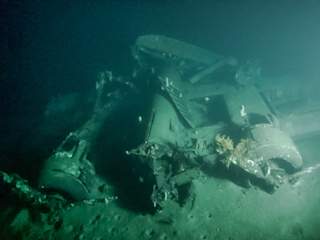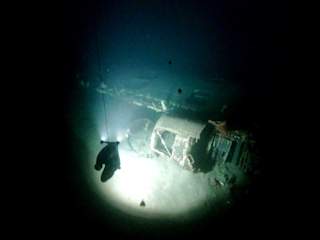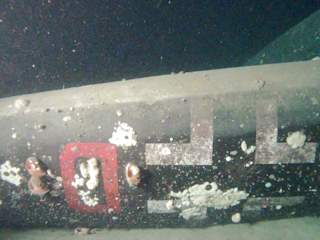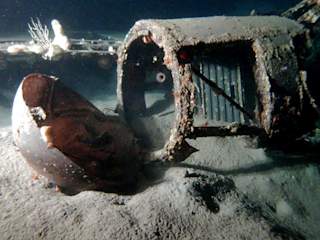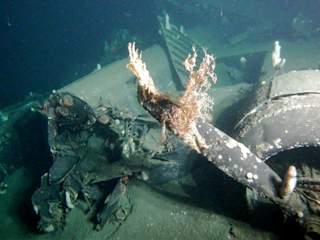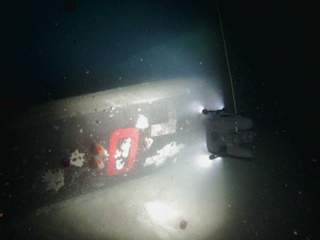Discovery by the 1st Minesweeper Squadron
Hugin is an AUV (Autonomous Underwater Vehicle) produced by Kongsberg Maritime and is one of the world's most advanced and capable underwater vehicles. It can dive down to the depth of 6000 meters and uses sonars, echosounders, and cameras to map the seabed. Hugin is wireless and can be pre-programmed to search over a large area at a given altitude above the seabed. It resurfaces once its mission is complete, and the data can be downloaded and analyzed.


The 1st Minesweeper Squadron has two container-based autonomous mine-hunting systems based on Hugin, which can be loaded onto different ships as needed.
In September 2022, the HUGIN Team 1of the 1st Minesweeper Squadron located the BV-222 aircraft at a depth of 318 meters. In March 2023, they found the HE-115 at a depth of 253 meters, just a few kilometers from the city center of Trondheim.

One of the challenges of Hugin is that it needs to maintain a certain distance above the seabed to avoid the risk of getting stuck in the wrecks. Therefore, the Minesweeper Squadron had not obtained close-up images of the aircrafts until Blueye was able to document the wrecks with two X3 underwater drones.
NTNU (Norwegian University of Science and Technology) has extensive experience with the combination of Hugin AUV and Blueye ROV. In 2022, they collaborated with FFI (Forsvarets Forskningsinstitutt) on "Mission Mjøsa". Hugin was used to map the lake bottom, while Blueye underwater drones were deployed to quickly investigate interesting findings. During the mission they discovered what could be the oldest known wreck in Norways largest lake.
Blohm & Voss BV-222 Wiking V2
The first wreck discovered by the Minesweeper Squadron, was quickly identified as the legendary Blohm & Voss BV-222 Wiking V2 seaplane. This 6-engine aircraft was the largest German seaplane operational during World War II. Originally built as a passenger plane, only 13 of these aircraft were ever produced. The massive aircraft has a wingspan of 46 meters, a length of 37 meters, and a height of 10.9 meters.


In Trondheim, this aircraft is well-known among history enthusiasts. After Germany's surrender in May 1945, two BV-222s were found in Sørreisa. Both were flown to Trondheim in June 1945. BV 222C-012 was transferred to the British Royal Air Force (RAF) base in Calshot, England. BV 222 V2 remained in Trondheim and was moored off Skansen until October 1945. The U.S. Naval Flight Test Division conducted test flights but found little use for it. After experiencing engine problems, on October 10th the British decided to sink the aircraft. It was filled with surplus material from the old German seaplane harbor in Islvika, towed out into Trondheimsfjorden, and sunk. Since then, the exact location where the aircraft went down has remained unknown.


Local diving legend Kaj Sjølie had been searching for the wreck for decades. In 2003, Kaj believed he had finally found the BV-222 at a depth of 60 meters off Munkholmen. However, it turned out to be the wreck of the Short Sunderland, which Blueye later visited numerous times.
The discovery of the Short Sunderland in 2003 led to new information about the BV-222 surfacing. Gunnar Bjørnshol told Adresseavisen that he had photographed the sinking of BV-222 from his home in Sverresli in 1945. In the news article, Bjørnshol mentioned that he had tried to locate the exact spot on the sea chart where the aircraft went down and estimated it to be at a depth of 300 to 350 meters. This estimation proved to be accurate. On September 25, 2022, almost 77 years after the aircraft was sunk, it was rediscovered at a depth of 318 meters, approximately one and a half nautical miles north of Østmarktangen lighthouse.


The fact that the wreck lies at a depth of 318 meters makes it the deepest wreck ever visited by Blueye. One of the success factors for operating at such depths is keeping the boat steady. To achieve this, we have installed an electric MotorGuide GPS outboard motor on the bow of our 19-foot Buster boat. This motor ensures that the boat remains in the same position without the need for anchoring or using the boat's main engine. We previously discussed utilizing this type of GPS motor as an alternative to anchoring in an article about the vulnerable deep-sea corals on the Tautra Reef.

Even though we had a secure position from the Minesweeper Squadron, the Oculus M750d multibeam sonar was helpful in quickly locating the wreck as we approached the seabed. Visibility can be poor, and during the 10 minutes it takes us to descend to 320 meters, there is a chance of drift from the starting point.
The aircraft lies upside down on the seabed, submerged about half a meter into the soft sediments. The fuselage has broken in two on its way down, and the tail section is located 250 meters away from the wing section. All six engines are still attached to the wings. Where the tail has broken off, it is possible to enter the fuselage using the small Blueye ROVs.
Heinkel HE-115 S4+DK
The second new aircraft found is a Heinkel HE-115. This aircraft type is well-known in Trondheim. There are two HE-115 aircraft wrecks at a depth of about 40 meters in Ilsvika, where the Germans had a seaplane base during World War II. Blueye has visited and published videos from these wrecks several times before.


However, this time, it's a new discovery at a depth of 253 meters off Høvringen, a bit further out in the fjord. This is an entirely new find that had not been previously known. The Justice Museum conducted a thorough investigation of the discovery and identified the aircraft as S4+DK. This was one of the 15 HE-115s that took off from the island of Sylt on the west coast of Schleswig-Holstein on April 9, 1940, bound for Trondheim. The aircraft were to operate from Trondheim as reconnaissance planes along the coast from Trondheim to Nordkapp.


Knut Sivertsen at the Justice Museum writes:
In Trondheim, the 15 aircraft landed on April 9 in several groups between 0800 and 1600. Landing went smoothly for 14 of the planes, despite some damage to the pontoons due to the rough sea. However, it went worse for Staffelkapitän and mission leader Hauptmann Lienhart Martin Wiesand's aircraft. On the way north, the aircraft was fired upon by an English Sunderland flying boat from the Royal Air Force, and the aircraft sustained damage to the fuselage and pontoons, forcing Wiesand to land quickly. He attempted to land the aircraft on the fjord northwest of Munkholmen, but the landing failed, and the aircraft went up on its end and quickly sank. All three on board managed to exit the aircraft, but Wiesand disappeared.
Sivertsen has investigated whether this should be considered a war grave if Wiesand went down with the wreck. His research has shown that this was not the case, as the pilot was found and likely cremated in Trondheim before the urn was returned to Germany.
The aircraft wreck lies upside down on the seabed. The wings and engines are attached to the fuselage. The glass dome at the front of the cockpit has come loose but appears to be mostly intact. On the fuselage, you can clearly see the identifier "D" painted in red next to the beam cross under the wings. Like wrecks, a thriving marine life community has settled around and on the wreck, including jellyfish, shells, sponges, deep-sea corals, shrimp, ling, and cusk.
To capture the best possible images, we used two Blueye X3 vehicles, where one was equipped with four additional lights.









The Aircraft Graveyard in Trondheimsfjorden
Since day one, exploring what lies beneath the surface has been a driving force for the Blueye team. As our technology has matured, we have expanded our reach to go deeper and operate longer. The integration of additional payloads such as underwater positioning and sonars allows us to quickly locate wrecks even at great depths. Over time, we have become well-acquainted with some of the history lying on the bottom of Trondheimsfjorden.
Trondheim was a strategically important city during World War II. Tirpitz, one of the two largest battleships in the German navy, spent long periods at anchor in Åsenfjorden, a sidearm of Trondheimsfjorden. Numerous air raids were conducted against Tirpitz, and several allied aircraft were sunk while entering or leaving Trondheimsfjorden. German aircraft operated from airports at Værnes and Lade, as well as seaplane bases at Jonsvatnet, Ilsvika, and Hommelvika.

In 1994, Adresseavisen published an article about the "aircraft graveyard in Trondheimsfjorden," describing some of the aircraft believed to be in the fjord. The overview provides a glimpse of the significant air activity over Trondheimsfjorden during World War II. Since then, several of these aircraft have been found and documented. With the discovery of BV-222-Wiking-V2 and HE-115 S4+DK, two new aircrafts now have a known exact location on the map.
It has been nearly 80 years since World War II. Above water, most traces have disappeared. Underwater, however, we can still see the ship and aircraft wrecks as tangible reminders that Norway was once occupied and at war not too long ago. Saltwater and the forces of the sea are taking a toll on these wartime relics, and their condition is rapidly deteriorating. Documenting and sharing local history is an exciting and rewarding endeavor for us at Blueye while also serving as an excellent way to test the technology we develop.
On our YouTube channel, we have compiled a playlist of videos created after dives on various historical wrecks.
UPDATE 19.10.23
After publication, we have been contacted by Chandos Publications, who have recently published the book Heinkel He 115 – Development and Operational History, 1937-1952. They are reasonably certain that the aircraft's identity is 'S4+DH' and not 'S4+DK'.

